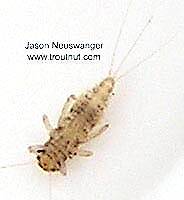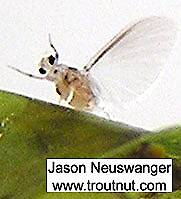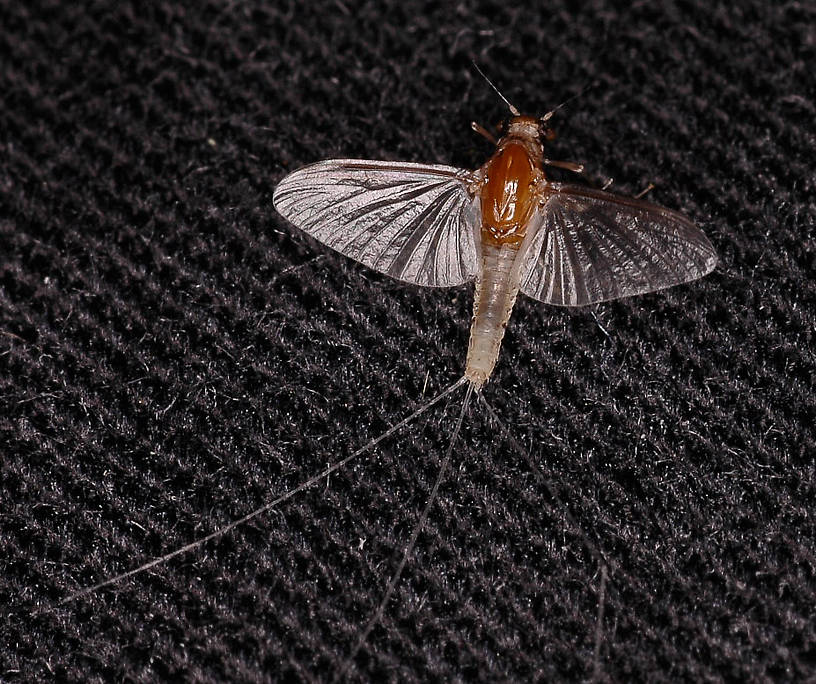
Blue-winged Olives
Baetis
Tiny Baetis mayflies are perhaps the most commonly encountered and imitated by anglers on all American trout streams due to their great abundance, widespread distribution, and trout-friendly emergence habits.
Featured on the forum

It's only barely visible in one of my pictures, but I confirmed under the microscope that this one has a prosternal horn and the antennae are mid-way between the eyes and front of the head capsule.
I'm calling this one Pycnopsyche, but it's a bit perplexing. It seems to key definitively to at least Couplet 8 of the Key to Genera of Limnephilidae Larvae. That narrows it down to three genera, and the case seems wrong for the other two. The case looks right for Pycnopsyche, and it fits one of the key characteristics: "Abdominal sternum II without chloride epithelium and abdominal segment IX with only single seta on each side of dorsal sclerite." However, the characteristic "metanotal sa1 sclerites not fused, although often contiguous" does not seem to fit well. Those sclerites sure look fused to me, although I can make out a thin groove in the touching halves in the anterior half under the microscope. Perhaps this is a regional variation.
The only species of Pycnopsyche documented in Washington state is Pycnopsyche guttifera, and the colors and markings around the head of this specimen seem to match very well a specimen of that species from Massachusetts on Bugguide. So I am placing it in that species for now.
Whatever species this is, I photographed another specimen of seemingly the same species from the same spot a couple months later.
I'm calling this one Pycnopsyche, but it's a bit perplexing. It seems to key definitively to at least Couplet 8 of the Key to Genera of Limnephilidae Larvae. That narrows it down to three genera, and the case seems wrong for the other two. The case looks right for Pycnopsyche, and it fits one of the key characteristics: "Abdominal sternum II without chloride epithelium and abdominal segment IX with only single seta on each side of dorsal sclerite." However, the characteristic "metanotal sa1 sclerites not fused, although often contiguous" does not seem to fit well. Those sclerites sure look fused to me, although I can make out a thin groove in the touching halves in the anterior half under the microscope. Perhaps this is a regional variation.
The only species of Pycnopsyche documented in Washington state is Pycnopsyche guttifera, and the colors and markings around the head of this specimen seem to match very well a specimen of that species from Massachusetts on Bugguide. So I am placing it in that species for now.
Whatever species this is, I photographed another specimen of seemingly the same species from the same spot a couple months later.

Troutnut is a project started in 2003 by salmonid ecologist Jason "Troutnut" Neuswanger to help anglers and
fly tyers unabashedly embrace the entomological side of the sport. Learn more about Troutnut or
support the project for an enhanced experience here.
Angler's Curses
Database Error: You have an error in your SQL syntax; check the manual that corresponds to your MySQL server version for the right syntax to use near 's-Curses', '1713604569', 'Mozilla/5.0 AppleWebKit/537.36 (KHTML, like Gecko; com' at line 1
Generated by query:
REPLACE INTO users_guest VALUES ('3.15.211.107', 'https://test.troutnut.com/common-name/37/Angler's-Curses', '1713604569', 'Mozilla/5.0 AppleWebKit/537.36 (KHTML, like Gecko; compatible; ClaudeBot/1.0; +claudebot@anthropic.com)')Backtrace:
__construct <— initRegistry <— require_once
Missing Parameter Error: Malformed parameter "Angler's-Curses".
This common name refers to only one family. Click its scientific name to learn more.
Mayfly Family Caenidae
These are often called Angler's Curses.
The tiny mayflies of this family are usually found in warm, slow, marginal trout water, although some trout streams hold good populations too.
The only genus ever known to produce fishable hatches is Caenis. It turns up frequently for anglers who sample nymphs, but it is rarely of any practical importance for fly fishing because its emergence traits and tiny size (even smaller than Tricorythodes) make it relatively unimportant.
Brachycercus is even more focused on warm water than Caenis.
The only genus ever known to produce fishable hatches is Caenis. It turns up frequently for anglers who sample nymphs, but it is rarely of any practical importance for fly fishing because its emergence traits and tiny size (even smaller than Tricorythodes) make it relatively unimportant.
Brachycercus is even more focused on warm water than Caenis.

I confirmed the identity of this nymph by looking at it under a microscope to be certain of the shape of its gills and head.
See 8 more specimens...



